PAGE 59 – March 2007
H O T I D E A S F O R S M A L L R A I L R O A D S
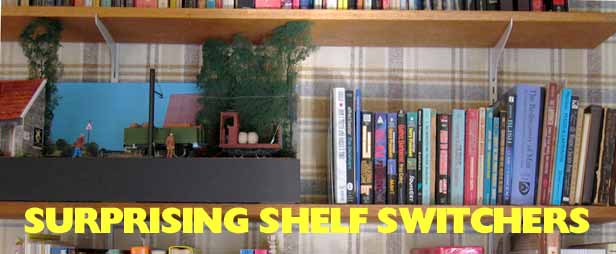
This month’s Scrapbook has two parts. The first is layouts that run
in circles, providing continuous operation. This is the kind of layout
that is perhaps most familiar to beginning modelers — and it is indispensable
in planning for layouts that are on display, at exhibitions or at home.
The second section of this month’s Scrapbook is a special tribute
to the world’s first model railway exhibition devoted entirely
to layouts that have appeared in this Scrapbook! It’s being held
in Worcestershire and sponsored by a Scout troop
led by a zealous modeler and contributor to this site.
TWO OF A KIND FROM AUSTRALIA
John Henshaw, from Swan Bay, Tasmania Australia, is building a series of HOn30/HO9 “cubical” layouts that are 500mm (20in) on a side. All have a circle of track for continuous running, because John likes to watch the trains run. We explored two of his projects in Scrapbook #56, and this month we look at a new work-in-progress — a tasty winery tram called Chateau de Plonque — and we update our construction report about one of his previously described pikes, the Toolybuc Sugar Company.
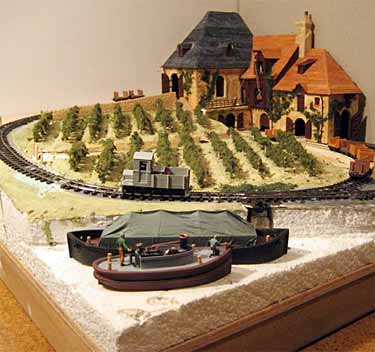
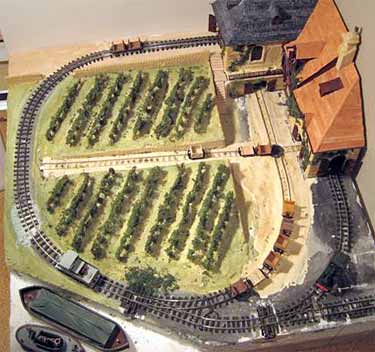
Though it’s not yet completed, John has provided us a tasting of Chateau de Plonque, his busy tramway serving the estate winery. The line is busiest in the grape picking season, bringing bin loads of grapes back to the main winery from collection points on the hilly estates. John has modeled both the winery and (unusually) a typical vineyard close by.
The tramway also transports workers to and from the estate. In the off-season it keeps busy carrying new vine posts and wire out to the vineyards, collecting and disposing of the vine prunings, hauling barrel-making timber from the canal boats to the coopers, and delivering barrels of matured wine to the SNCF station.
The little road is operated by small, diesel-engined locomotives, mostly manufactured by Egger-Bahn, with a variety of tiny tipping wagons as well as other, more specialised wagons used for carrying barrels. The year is 1947. It promises to be a bumper harvest.
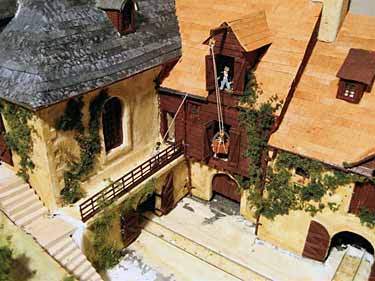
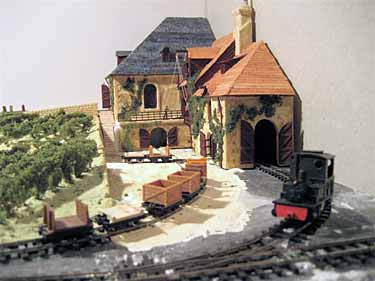
(Update from Carl: Several sharp-eyed readers have commented that the two ends of the Chateau’s “continuous circle” are at different elevations, making it difficult for them to meet inside the winery. I consulted with John Henshaw about this, and he confirmed that the circle will eventually be closed by a more gently sloped external addition to the layout, but right now it’s a point-to-point operation. I misinterpreted his original description — apologies to all! The layout is so much fun and so widely admired, though, that I’m leaving it in place for your enjoyment. John will be pleased to correspond with interested modelers; he can be reached at eaglehawkbluff-AT-bigpond-DOT-com.)
Toolybuc Sugar Co-operative Limited is a mythical company in the imaginary region of Toolybuc, located in the tropical country at the far north of Queensland. It is typical of many cane-sugar enterprises in Oz that have been intertwined with narrow-gauge railways since the 19th century. This one has fallen on hard times in 1934. As John describes it, “The rolling stock is old and badly worn. Derailments are commonplace, and the train crews have become adept at winching, jacking, and sometimes simply driving the locomotives and rolling stock back onto the rails.
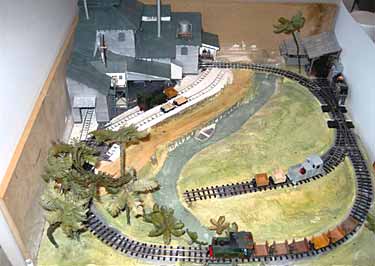
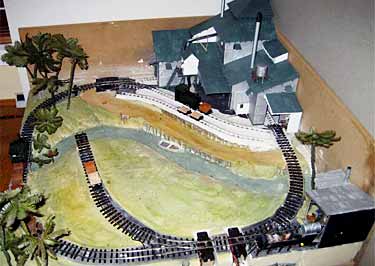
“If the permanent way seems a bit rough, it’s nothing compared to the temporary tracks that are laid directly onto the ground. These tracks have a minimum number of sleepers [crossties] and are without ballast. They are laid wherever required to get as close as possible to where the cane is cut by hand. Lengths of sugar cane — blackened from having been burnt off earlier — are loaded, also by hand, crosswise onto the small wholestick cane trucks, until the trucks are barely visible under the untidy loads. The cane is dumped inside the mill and the string of empties returned for another load. This feverish activity continues right through the short cane-cutting season and often through the night.”
John has done an excellent job of capturing the romance of the sugar cane industry on the lush, tropical Queensland coast!
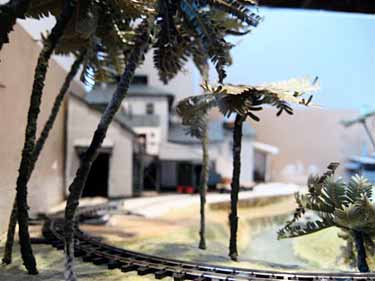
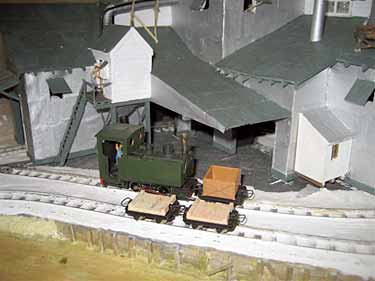
A CIRCULAR INDUSTRIAL TRAMWAY WITH MINING BRANCH
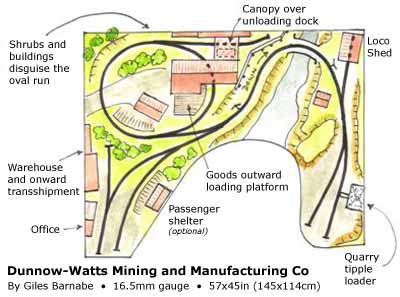
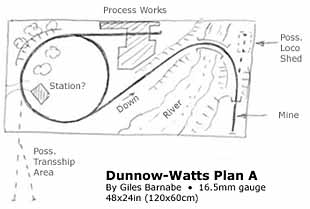
The cunning plan directly above, labelled Plan A, is the first phase of a layout-design project to accomplish the “mostest with the leastest.” The prolific Giles Barnabe, who lives in London, England, set out to get the most possible railroading using the fewest possible points [switches], the least amount of track, and the smallest area that would provide good operation. Plan A was his attempt to create a design that would fit that description — inexpensive and quick to build, lots of fun to “play with” after construction.
“After that,” says Giles, “the ideas grew a little!” The result is the Dunnow-Watts Mining and Manufaacturing Co. (above right). It’s a busy industrial line in the space of 57×45 inches. It’s designed with relatively-generous eight-inch radius curves, so can be used with narrow gauge trains in either 16.5mm or 9mm gauges. Choice of scale is up to the builder. It can be Gn15, #1n21 or On30 (in 16.5mm gauge) or On18, Sn2, or HOn30 (in 9mm guage). To see the full spectrum of scale/gauge choices, check out “Carl’s Guide to Scales and Gauges.”
The DWMMR performs two vital tasks: (1) it delivers open cars filled with whatever raw material is being quarried at the righthand side. The cars are filled from the tipple before our very eyes, then unloaded (tipped) in a covered installation at the factory, at the other end of the branch; and (2) the little line hauls finished products from the “goods outward loading platform” over to the transshipment warehouse, where they’re reloaded onto [gasp] lorries [trucks] and go off to market.
There’s even provision for a rudimentary passenger service, perhaps to bring workers out from town to the rural works in a railcar. And of course, engine housing and maintenance facilities are provided for the little narrow-gauge railway. And for people who like to see trains go by, there’s a continuous run as well (and it doubles as a runaround loop or passing siding!)
Truly, this little line provides an amazing amount of railroading with very limited means!
A TRADITIONAL CIRCLE FOR THE HOLIDAYS
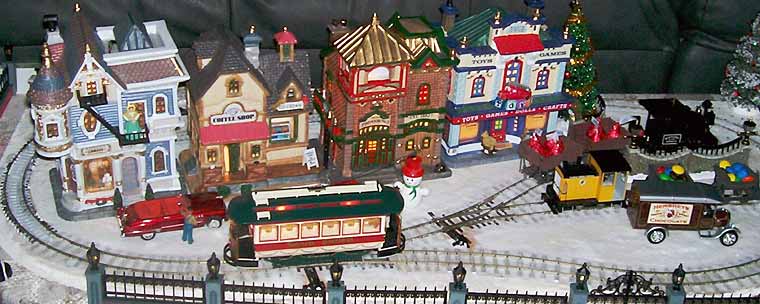
Eleven-year-old Lars Knapp put together this 32x16in (80x40cm) On30 Christmas layout (with some help from his dad) as a holiday treat for his mother, Sue. It runs on DCC, uses inexpensive drug-store village buildings, and has three spurs in this tiny space (one is behind the buildings, to hold a train backstage). The layout resides with the Knapps in Charlotte, North Carolina, USA.
MIDWEST LANDSCAPE HIGHLIGHTS N CIRCUIT
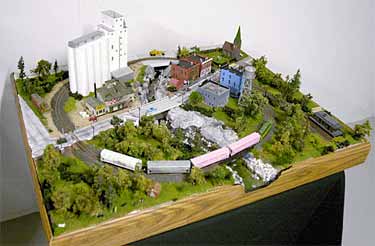
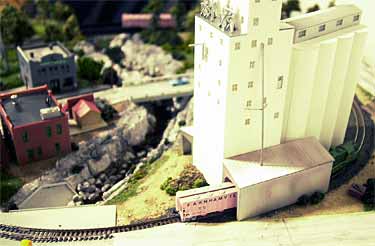
Dennis Book, from Loveland, Colorado USA, was inspired to build this 3×2.5ft (91x76cm) N-scale railroad by the delightfully landscaped Japanese layouts in Scrapbook #51.
“The original idea,” Dennis explained, “was to create a small farming community that could be anywhere in the USA.” As it turned out, he zeroed in on the “Midwest grainger” look, and built the town of Sumware based on the Iowa Interstate Railroad.
In the process, Dennis added a characteristic grain elevator, a small-town main streeet, and a rock-strewn stream (which allows the road to cross over a couple nice bridges). Looks like fun, watching those big, fat grain hoppers cruise by on the main line, passing through well-modeled scenery!
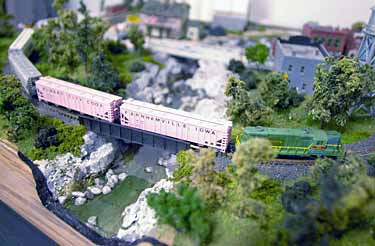
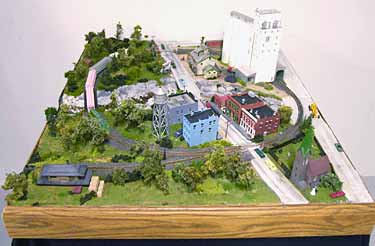

Well, we’re not exactly sponsoring this model railway exhibition,
the Hagley Rambler Scouts are doing that. They’re being led
by Chris Gilbert, whose work has appeared often in these pages.
As it happened, a high proportion of the layouts planned for exhibition
at this event (a fund-raiser in celebration of scouting’s 100th year)
had already been published in these pages.
So we agreed to feature all the layouts, in order that this can be
the world’s first exhibition of layouts featured in the Small Layout Scrapbook!
For more details and a map to the Hagley venue, see the group’s site.
(FYI, the event will occur on 20 October 2007 at the
Hagley Community Centre, Worcestershire, England.)
Here are some of the excellent layouts to be displayed there.
OO SCALE BRANCH TERMINUS INCLUDES AN INGLENOOK
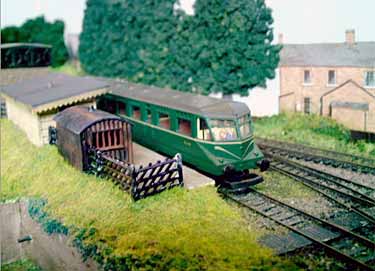
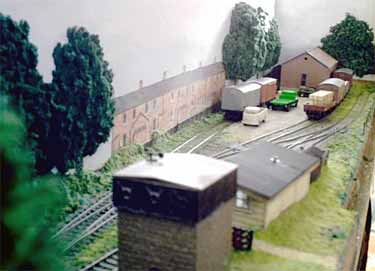
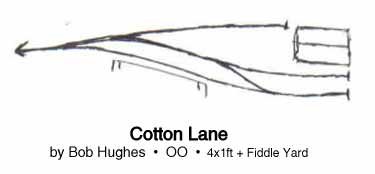 Cotton Lane, by Bob Hughes, from Sandbach, Cheshire England, is a small OO scale branch terminus. Bob generally operates it as a freelance line, using rolling stock from his collection; but for this exhibition he will run it, by request, as a freight-only British Railways branch in the late Sixties. There’s more information about the layout at Bob’s website.
Cotton Lane, by Bob Hughes, from Sandbach, Cheshire England, is a small OO scale branch terminus. Bob generally operates it as a freelance line, using rolling stock from his collection; but for this exhibition he will run it, by request, as a freight-only British Railways branch in the late Sixties. There’s more information about the layout at Bob’s website.
“The trackplan.” he reports, “is an Inglenook with added run round loop (the loop being also the platform road). The line disappears between overhanging trees into the fiddleyard. The visible part of the layout is just over four feet long, and the fiddle yard adds another three feet to the length.”
About the line’s outstanding features Bob wryly comments, “The layout does not have any innovative operating features, but the low relief trees often attract favourable attention at shows. The larger ones are made from sponge that has been put through the food processor and painted green before being attached to the backscene. The smaller ones are simply ground foam, glued into shape on cling film and then transferred from the cling film to the backscene when set.”
PAPER CRAFTSMAN BUILDS A PORTABLE LAYOUT
Photo by Steve Bennett, Sidelines Models

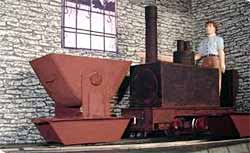
The “Patriarch of the Printie” in the English Midlands is Jim Snee, from near Lincoln. For a number of years, Jim has produced most of his rolling stock and layout scenery from heavy paper printed with his computer [see Hot Topics 4 — Material Matters]. Reviving a card craft often used in the early days of model railways, Jim has begun showing his methods and results at exhibitions in the vicinity of Lincoln, arousing great interest among the modelers in attendance.
To display his creations, Jim has recently built a rare “double shoebox” layout, made almost entirely of paper. He calls it the Portsmouth Street Tinplate & Engineering Works. The total footprint is 25×4.5in (64x12cm), and the scale is Gn15. The track plan is a simple straight line with a pair of tiny spurs. Scenery is paper, a mixture of dolls house stone papers and photographs printed with the computer.
Operation? Jim points out that each spur has its own truck (four-wheeled car). The tipper is stored on the left hand spur, the flat on the right. The default position for the Locomotive is on the back track to the right hand side (where the driver’s tea is brewing). The two rooms have features tied to the operation. On the extreme right at the back (behind the Loco) is a hatch through which goods can be loaded (or unloaded) onto the flat. In the roof on the right is a chute, from which waste materials can be poured into the tipper. In the roof on the left is the hatch for a winch system.
Obviously, there’s a lot to do on this little tramway. Jim will be showing it off at the Hagley Ramblers exhibition.
A GERMAN VERSION OF BOX STREET YARD
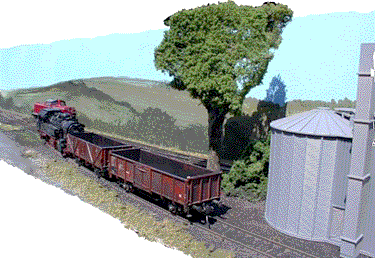
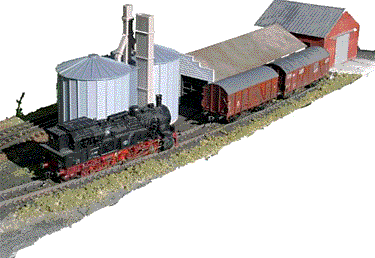
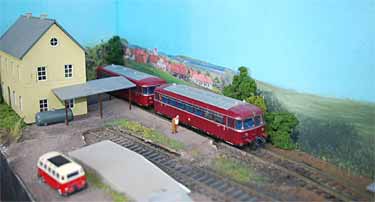 Transporting a classic US/British track plan to Germany is the impressive feat performed by Nick Palette. His HO layout, Box Straße, is based on Jack Trollope’s well-known Box Street Yard, but set in the German countryside. The baseboard measures 66x10in (168x25cm).
Transporting a classic US/British track plan to Germany is the impressive feat performed by Nick Palette. His HO layout, Box Straße, is based on Jack Trollope’s well-known Box Street Yard, but set in the German countryside. The baseboard measures 66x10in (168x25cm).
A ‘TYMESAVER’ LAYOUT FROM WALES
John M. Hughes, from Tregaron in West Wales, is exhibiting a four-foot-long OO layout called Morna Yard (more’n a yard, so to speak). According to John, “It represents a little inner-city goods facility [freight handler] of the sort that was quite common around London and some UK other cities right up to the late 1950s and early 60s.” [Ed. note: This small layout should not be confused with the Inglenook design shown elsewhere on this site.]
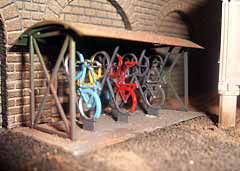
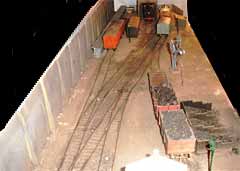
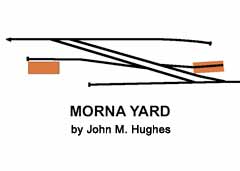
AND HERE’S ANOTHER BOX STREET — IN O SCALE!
Mike Bragg is primarily a layout and model builder. As he says, “It’s the journey from conception through all the building stages that I enjoy — if you like, from woodwork to scenery with stock building thrown in.” He’s enjoying himself to the fullest building Lenches Bridge, an O scale branch line set in the western Black Country of the English Midlands.

Mike continues, “Like many modellers I find space is at a premium, and to model in 0 gauge was always going to be a challenge. I opted for an overall size of 9×1.5ft using three baseboards. The track plan was kept simple based on a Box Street design, consisting of one left hand point [switch] and a double slip. One board contains the left hand turnout, the centre board the double slip, whilst the third contains a sector plate — simple.”
One scenic priority was a silted out-of-use canal basin along with a partly submerged butty (canal boat) and a careworn transshipment shed. Rolling stock includes a 57xx Pannier Tank, a B4 dock tank, and a Manning Wardle 0-6-0, all built from kits. Wagons are a mixture of kits and include a classic GWR six-wheeled brake van. A single Autotrailer coach provides passenger accommodations.
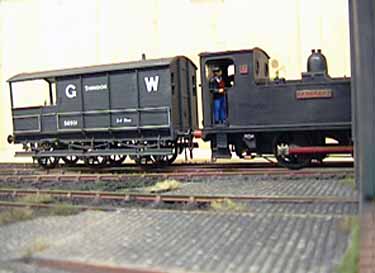
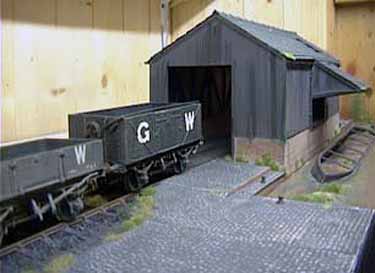
Leave a Reply